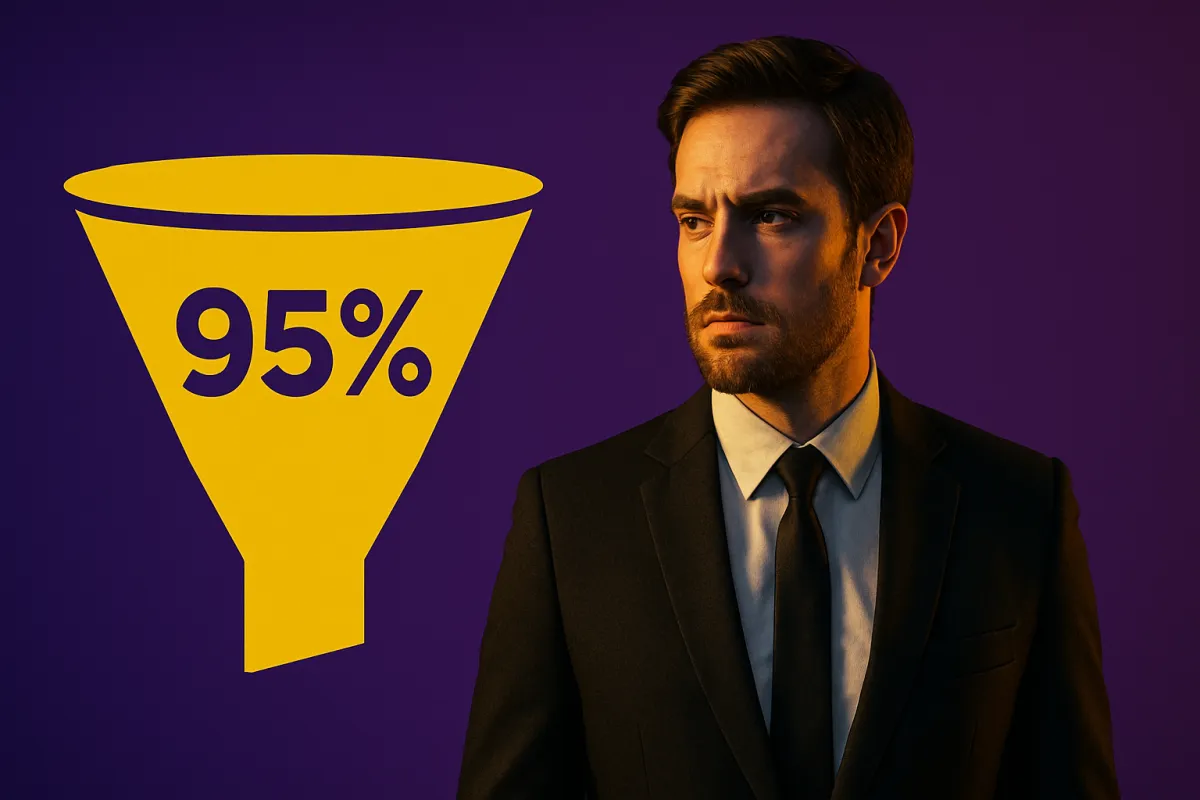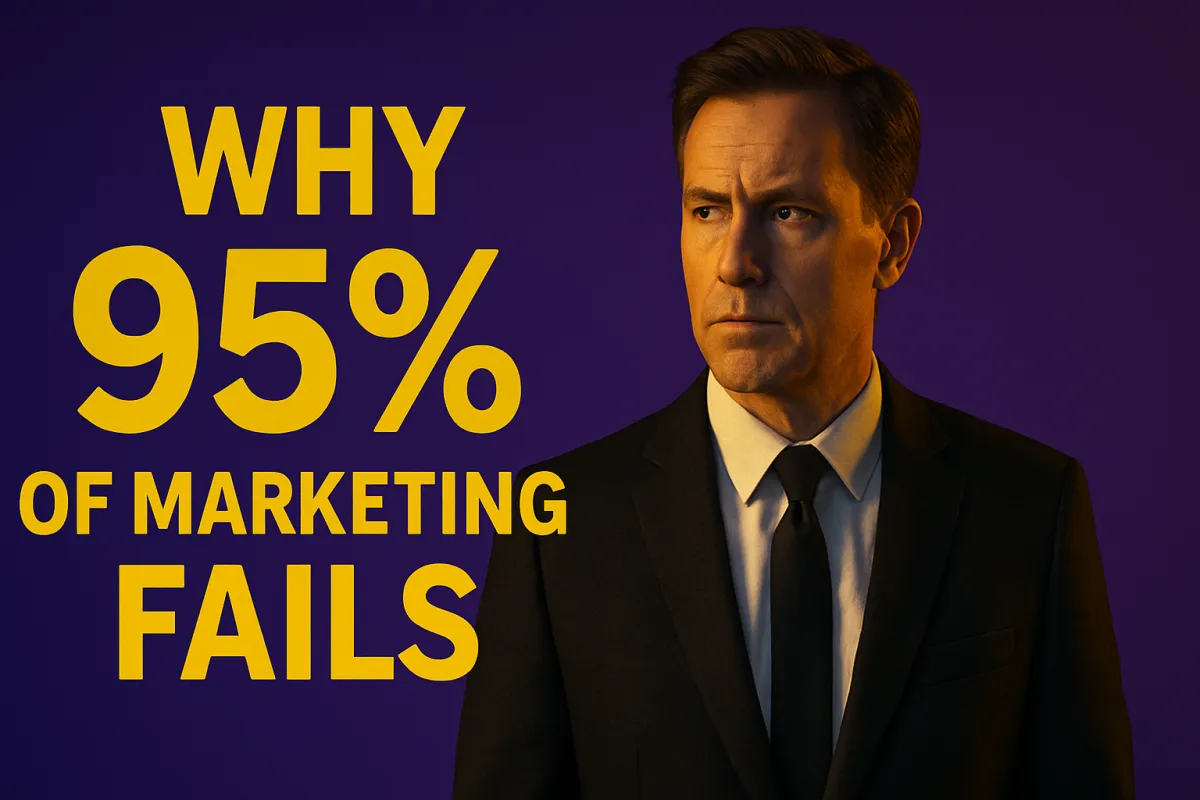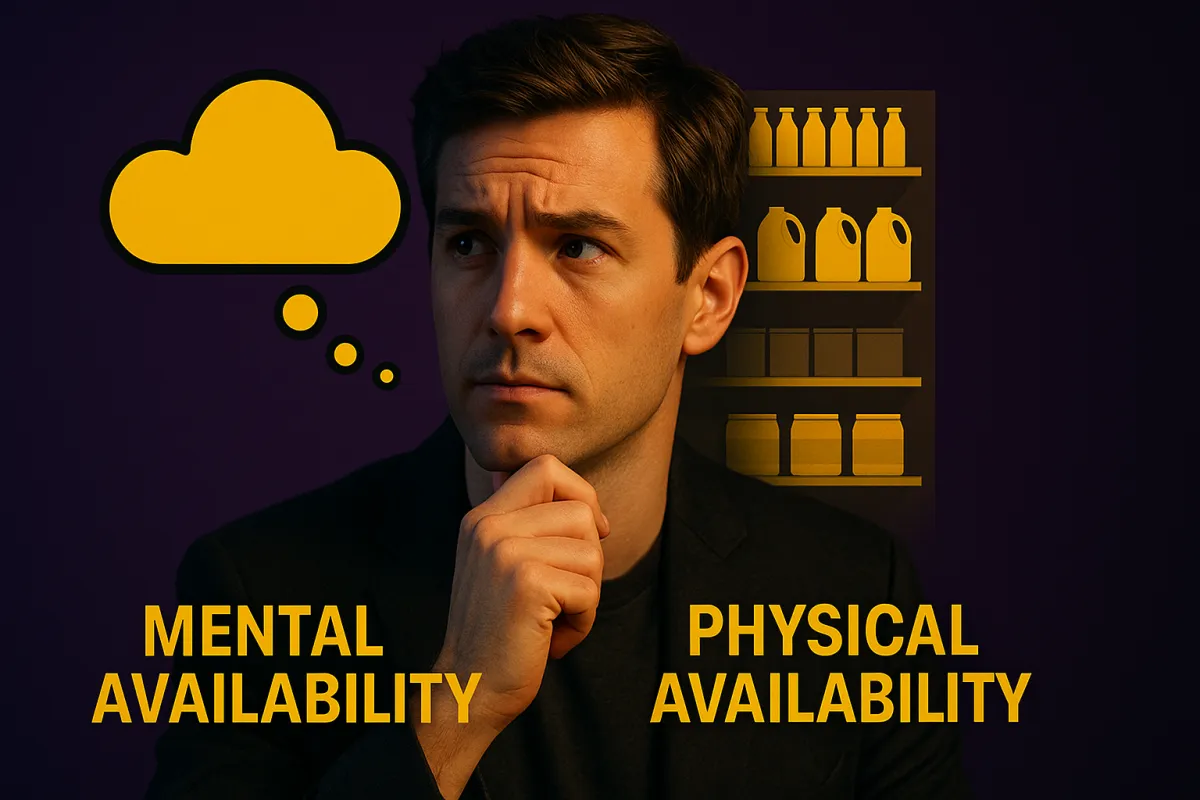By German Tirado, July 28, 2025
Table of Contents
Introduction: Why Most Brands Get Growth Wrong, and What 95% of Marketers Miss
What Is the 95-5 Rule in Marketing?
Why Focusing Only on In-Market Buyers Is a Growth Trap
Mental Availability vs. Physical Availability: What’s the Difference?
The Science of Memory: How Buyers Really Buy
Why Out-of-Market Buyers Are More Valuable Than You Think
How to Build Mental Availability with Out-of-Market Buyers
Metrics That Matter More Than Clicks
Conclusion: Market Beyond the Moment, Because Memory Drives Growth
Frequently Asked Questions (FAQs)
Works Cited
Introduction: Why Most Brands Get Growth Wrong, and What 95% of Marketers Miss

Marketers love a good funnel. Especially the bottom of it.
We obsess over “hot leads,” craft PPC ads for people actively comparing solutions, and fine-tune conversion rates for buyers who are already shopping. After all, it’s easy to justify spend when clicks and conversions are rolling in.
But what if we told you that this approach, while logical, completely ignores where the real brand growth comes from?
According to research from the Ehrenberg-Bass Institute, up to 95% of your category buyers aren’t in-market right now [95-5]. They’re not searching, not clicking, and not filling out contact forms. They’re busy doing their jobs, running their lives, and most importantly, not thinking about you.
This insight, known as the 95-5 Rule, upends the traditional idea that advertising should be aimed squarely at ready-to-buy customers. It shows that the majority of your ad impressions will land on buyers who won’t enter the market for months or even years. And that’s not a flaw, it’s an opportunity.
Because when those buyers do enter the market, what they remember matters more than what they find. Familiarity trumps features. Memory beats retargeting. Mental availability, being easy to think of in a buying moment, is the critical factor that determines whether you make the shortlist or get ignored entirely [HBG1] [CEP-B2B].
Yet most brands focus only on immediate ROI. They pour budget into bottom-funnel clicks while neglecting the long-term, memory-building power of broad-reach brand advertising. The result? Stunted growth, short-lived campaigns, and brands that get forgotten when it counts.
This article will unpack the science behind the 95-5 Rule, explain the difference between Physical and Mental Availability, and offer proven strategies to reach, and stay top-of-mind with, the 95% of buyers who aren’t shopping today, but will be tomorrow.
If you're serious about scaling your brand, it's time to stop playing the short game and start investing in the audience that actually fuels your future.
What Is the 95-5 Rule in Marketing?

The 95-5 Rule was coined by Professor John Dawes of the Ehrenberg-Bass Institute. It states:
“At any given moment, only about 5% of category buyers are in-market. The remaining 95% are out-of-market and not actively shopping” [95-5].
This pattern has been verified across both B2C and B2B markets, including insurance, SaaS, banking, retail, and telecommunications.
Why is this important?
Because it changes the way we think about advertising. If only 5% of people are shopping, then advertising that only targets today’s buyers is missing tomorrow’s revenue.
Why Focusing Only on In-Market Buyers Is a Growth Trap
Many marketers are trained to chase short-term metrics like:
Cost per click (CPC)
Cost per acquisition (CPA)
Lead-to-close rate
But these metrics are symptoms of immediate conversion, not drivers of long-term growth. By narrowly targeting those already in-market (through PPC, intent platforms, or retargeting), brands:
Hit a natural ceiling on growth
Face expensive competition for the same small audience
Miss the opportunity to shape memory in the broader market.
This is known as the efficiency trap: chasing visible results while missing invisible gains. And those invisible gains? That’s where brand growth actually happens.

Mental Availability vs. Physical Availability:
What’s the Difference?

Let’s borrow some Ehrenberg-Bass fundamentals:
Physical Availability is about being easy to buy. That’s shelf space, price point, distribution, and “findability” when the buyer is shopping.
Mental Availability is about being easy to think of. That’s memory structures, emotional cues, and “top-of-mindness” when the buyer isn’t yet shopping.
“Advertising to in-market buyers = Physical Availability work.
Advertising to out-of-market buyers = Mental Availability work” [HBG1].
Both matter. But most brands are over-indexed on Physical and underinvested in Mental, despite the fact that 95% of the audience lives there.
The Science of Memory: How Buyers Really Buy

When someone enters the market, they don't start with a spreadsheet. They start with a shortlist in their head, brands they've seen, heard, or felt before. These are triggered by Category Entry Points (CEPs):
“When our current provider fails…”
“When we open a new office…”
“When budget season hits…”
“Category Entry Points are the cues that activate brand memories in buying situations” [CEP-B2B].
Mental availability is about being linked to as many CEPs as possible, and refreshing those links regularly. Otherwise, you’ll be forgotten when buyers move into the 5%.
Why Out-of-Market Buyers Are More Valuable
Than You Think

Out-of-market buyers are:
Less expensive to reach via broad-reach media
Less competitive since most brands ignore them
More influential over time, because memory builds gradually
According to research across 17 insurance categories, each additional CEP linked to a brand lowered defection probability by 5% [CEP-B2B]. That’s retention and acquisition, powered by mental availability.
What You Should Do Instead:
A Science-Based Growth Plan

Here’s how to grow your brand the scientific way:
1. Focus on Acquisition
Reach new buyers broadly. Don't just “nurture your base.” Even your best customers are also buying from competitors.
2. Build CEP Memory Links
Run creative that links your brand to one specific CEP at a time (e.g., “When I need to reorder office supplies quickly”). Rotate over time to build a wide, fresh memory network.
3. Invest in Broad-Reach Media
Mass media (TV, radio, online video, Meta reach campaigns) works better for memory-building than narrow, hyper-targeted digital tactics [95-5 Rule].
4. Maximise Physical Availability
Be available in more places, formats, and channels than your competitors. This includes shelf presence, online findability, and user experience.
5. Measure Mental Availability
Track brand salience across multiple CEPs, not just brand recall or NPS. Use surveys or third-party brand tracking.
Common Pitfalls to Avoid

Over-reliance on loyalty metrics: These follow size. They do not drive it.
Narrow targeting: It may improve short-term ROI but fails to grow your customer base.
Obsession with differentiation: What matters more is distinctiveness—being recognisable in buying situations [BDA].
Conclusion: Loyalty Is a Byproduct of Scale
—Not a Shortcut to It

If you’ve been taught that brand loyalty is the cornerstone of growth, it’s time to update your mental model. The idea that “big brands are loved, and that love creates loyalty” is a myth, one that has misdirected millions in marketing investment.
The truth, supported by decades of marketing science, is clear: brand loyalty emerges as a statistical byproduct of having more customers. This is the Double Jeopardy Law in action: bigger brands enjoy both more buyers and slightly higher repeat purchase rates, not because of emotional bonds or brand love, but because they’re bought more often by more people [HBG1] [The Double Jeopardy Law in B2B shows the way to grow.pdf].
This has massive implications for how you build and scale your brand.
Rather than pouring budget into CRM schemes, community-building, or brand storytelling aimed at deep emotional resonance, you should shift focus toward customer acquisition strategies that expand reach, build memory structures, and increase brand salience. That means:
Running broad-reach advertising that builds your brand across mental availability triggers, or Category Entry Points (CEPs) [Category Entry Points in a B2B World.pdf].
Investing in distinctive brand assets—your logo, colors, jingle, tone of voice, that make your brand easily recognized across all media and touchpoints [BDA].
Increasing physical availability by making your brand easier to buy, in more places, at more times, and through more channels—online and offline.
Measuring what matters: penetration, mental market share, and CEPs coverage, not NPS, brand “love,” or sentiment scores [BBBH].
If you want brand loyalty, earn it the way big brands do: by being thought of and easy to buy—by more people, more often.
Big brands aren't big because they're loved. They're loved (or at least familiar) because they're big. They've achieved scale through consistent, science-backed marketing that prioritizes availability over emotion, penetration over personalization, and reach over retention.
So let’s retire the myth. Instead of chasing loyalty as a goal, pursue mental and physical availability relentlessly. Let loyalty emerge naturally, as a side effect of smart, scalable, evidence-based brand growth.
That’s how you grow a brand that doesn’t just feel good, but sells well.
Certainly. Here's an SEO-optimized FAQs section for the blog “More Loyalty Comes from More Buyers, Not ‘Brand Love’”:
Frequently Asked Questions (FAQs)
Q1: What is the 95-5 Rule in marketing?
The 95-5 Rule, developed by Professor John Dawes at the Ehrenberg-Bass Institute, states that only 5% of category buyers are in-market at any given time, while the remaining 95% are not currently shopping. This has profound implications for advertising strategy, brands must build memory among the 95% so they’re considered when those buyers eventually enter the market [95-5].
Q2: Why shouldn’t we focus only on in-market buyers?
Focusing exclusively on in-market buyers means competing for a small, expensive slice of the audience while ignoring the much larger pool of future buyers. It leads to diminishing returns and stunted brand growth. Mental Availability, built through advertising to out-of-market buyers—is what drives long-term success [HBG1].
Q3: What’s the difference between Mental and Physical Availability?
Mental Availability is about being easy to think of, linked to buying situations in memory.
Physical Availability is about being easy to buy, available in more channels, formats, and touchpoints.
Both are essential, but Mental Availability must be built before the buying moment arrives [HBG2].
Q4: How can I reach out-of-market buyers effectively?
Use broad-reach media like YouTube, Meta, or TV to consistently expose the full category audience to your brand. Link your ads to Category Entry Points (CEPs) such as “when budgets open,” “when a system fails,” or “when growing headcount,” and refresh each CEP at least twice per year [CEP-B2B].
Q5: How do I identify the right Category Entry Points for my business?
Use the “Revised W’s” framework:
When (e.g., during tax season)
Where (e.g., working remotely)
While (e.g., launching a new product)
With/Instead of What (e.g., switching platforms)
With or For Whom (e.g., buying for a team)
How Feeling (e.g., frustrated with current supplier)
Why (e.g., to scale operations)
These cues reflect the real mental triggers that prompt brand recall and purchase consideration [CEP-B2B].
Q6: What metrics should I use to measure success with out-of-market advertising?
Track Mental Market Share, Distinctive Asset Salience, Category Buyer Reach, Share of Search, and brand penetration over time. Avoid relying solely on short-term metrics like CPC or lead volume, they don’t reflect the brand-building work happening in memory [HBG1] [95-5].
Q7: How long does it take to see results from mental availability campaigns?
Mental Availability builds gradually. While some uplift can occur within 6 months, expect meaningful growth over 12–24 months. Think of it like planting seeds: the payoff comes when those buyers enter the category and your brand is top-of-mind [HBG2].
Q8: Does this approach work for both B2B and B2C brands?
Yes. While buying cycles and decision-making units may vary, the psychological laws of memory and salience apply to all humans, whether they're choosing a cloud platform or a cup of coffee [How B2B Brands Grow].
Works cited
[95-5]
Dawes, J. (2023). Advertising Effectiveness and the 95-5 Rule: Most B2B Buyers Are Not in the Market Right Now. Ehrenberg-Bass Institute for Marketing Science.
Available at: https://www.marketingscience.info/95-5-rule/
[HBG1]
Sharp, B. (2010). How Brands Grow: What Marketers Don’t Know. Oxford University Press.
[HBG2]
Sharp, B., & Romaniuk, J. (2015). How Brands Grow: Part 2. Oxford University Press.
[CEP-B2B]
Romaniuk, J. (2022). Category Entry Points in a Business-to-Business (B2B) World. Ehrenberg-Bass Institute for Marketing Science.
Available at: https://www.marketingscience.info/category-entry-points-in-a-b2b-world/
[How B2B Brands Grow]
Romaniuk, J., Dawes, J., & Sharp, B. (2022). How B2B Brands Grow. Ehrenberg-Bass Institute for Marketing Science.
Available at: https://www.marketingscience.info/how-b2b-brands-grow/
Address
Phone: 725-240-6870
Email : [email protected]
Address : 6440 Sky Pointe Dr. #140-341 Las Vegas, NV 89131
Artificial Intelligence
Marketing & Branding
Marketing & Branding
©2025 Max Digital Edge | All Rights Reserved
